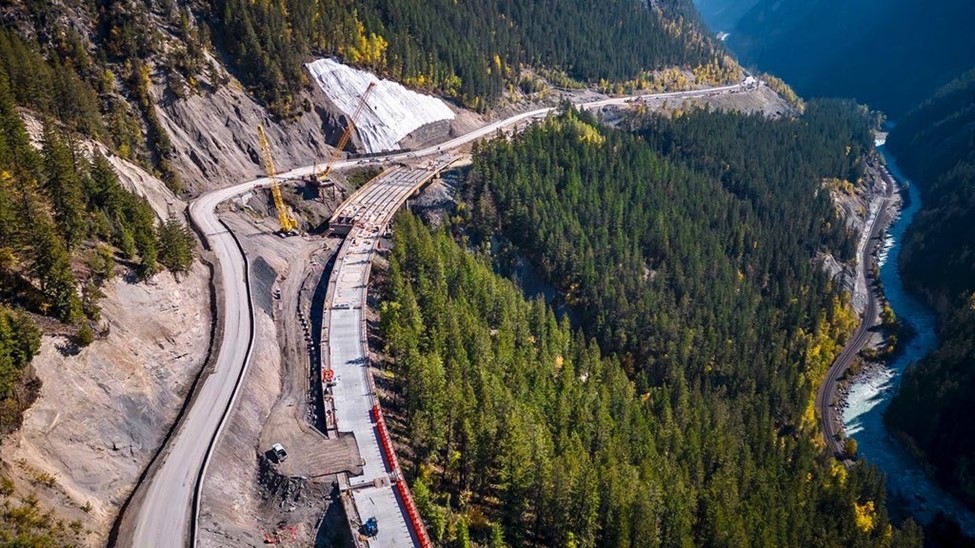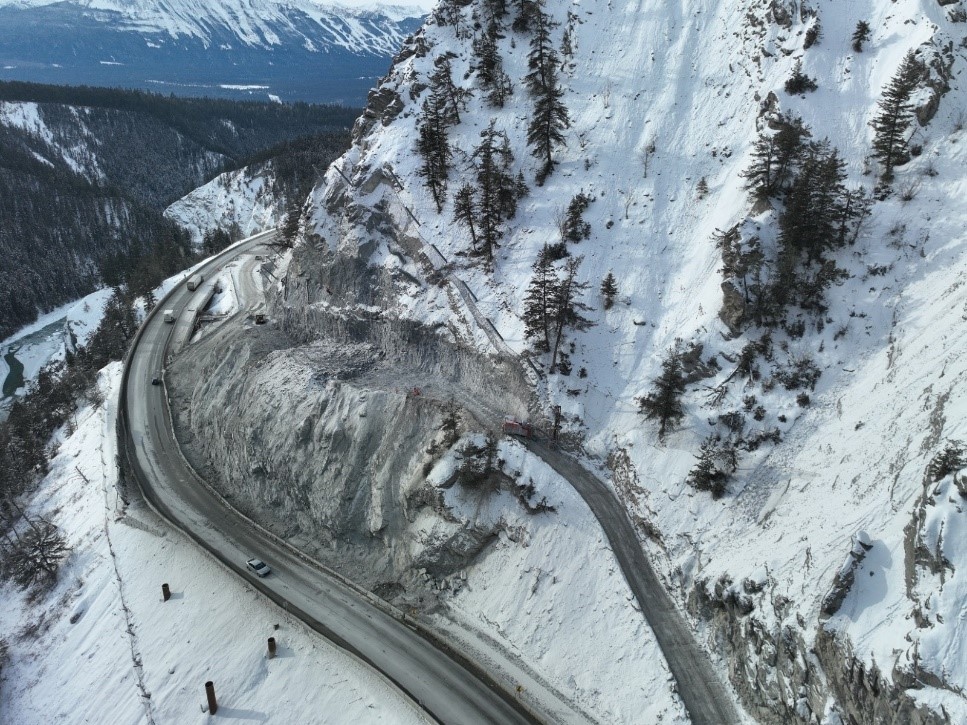TAC Sponsor Spotlight Article – Parsons

Project Overview
The Kicking Horse Canyon (KHC) highway improvement project, which reached Substantial Completion in November 2023, represents a significant upgrade to one of Canada’s most challenging and vital highway segments. This section of the Trans-Canada Highway (Highway 1) runs through steep terrain in a canyon prone to rockfall, avalanches, and debris flows, making it a high-risk area for both road users and infrastructure. The project was undertaken to improve safety, stability, and operational efficiency, and to enhance the resilience of the highway against increasingly severe weather events and geotechnical hazards.
The project was delivered by Kicking Horse Canyon Constructors (KHCC), a joint venture between Aecon Constructors (a division of Aecon Construction Group Inc.), Parsons Corporation, and Emil Anderson Construction. The Transportation Investment Corporation (TIC), representing the BC Ministry of Transportation and Infrastructure (MoTI), administered the Design Build contract. Parsons served as both a joint venture partner and the lead designer.
The project was developed as part of a broader initiative to enhance the Trans-Canada Highway between Kamloops and the BC/Alberta border, with funding provided by both the Province of British Columbia and the Federal Government. The new alignment significantly reduces exposure to environmental and geotechnical risks, and the safety improvements are expected to benefit both local communities and long-distance travelers for decades to come.
Key Outcomes
Geotechnical and Environmental Mitigation:
The KHC project was focused on reducing risk from geotechnical hazards, including avalanches, rockfall, and debris flows. Specific measures included:
- Avalanche Mitigation: The Kicking Horse Canyon area is prone to avalanches, and 12 defined avalanche paths were mapped and treated. Each path had unique characteristics, such as varying terrain, vegetation, and exposure, which determined the specific avalanche type and associated impact load. To ensure highway safety, the new structures were designed to withstand one in 300-year return period avalanche loads, while avalanche ditches were incorporated to store snow and debris. These ditches ranged in width from five meters to over 16 meters. Sophisticated modelling techniques were used to determine the best ditch configurations while minimizing the environmental impact and balancing snow storage with the need for effective slope protection.
- Rockfall Attenuation: In areas prone to rockfall, KHCC implemented advanced 3D rockfall modelling to predict and mitigate rockfall hazards. The modelling considered existing and new slopes, the highway alignment, and potential loose rocks. Rockfall attenuators were installed along 1.25 km of the highway, providing 95% retention of all potential rockfall in the most vulnerable areas. The attenuation system, rated for impact forces up to 6,000 kJ, is the highest-rated rockfall protection system in Canada.
- Slope Stabilization: One of the most critical areas for stabilization was the Pronghorn Slide, a major active landslide zone. To address slope stability, the project incorporated viaduct structures with piles anchored deep into bedrock, reducing the long-term load on unstable slopes. Additionally, excavation and dewatering techniques were used to alleviate pressure on the slope. This innovative approach was essential to minimize risks to both the highway and the Canadian Pacific Kansas City (CPKC) railway, which runs below the highway through the canyon and carries 30 trains per day.

Utility Protection and Relocation:
One of the major hazards along the highway corridor was the vulnerability of existing utilities—BC Hydro power lines and Telus communication cables mounted on overhead poles. These utilities were exposed to rockfall and avalanche hazards, occasionally causing unplanned outages for the community of Field, BC.
As part of the highway upgrade, these utilities were relocated underground to the upslope shoulder, protected from rockfall and avalanche impacts by lock block enclosures. For utility lines running under bridges and viaducts, suspended hanger systems were employed to protect the lines from exposure to severe weather and geohazards. This relocation and protection of critical infrastructure help ensure long-term reliability for the region’s power and communications systems.
Safety Enhancements:
The project included significant road safety improvements, which will have long-term benefits for highway users.
- Widening to Four Lanes: The highway was expanded from two to four lanes, with a divided median, allowing for additional passing opportunities and increased traffic capacity. The road was also upgraded to a 100 km/h speed limit, aligning with other upgraded segments of the National Highway System.
- Wildlife Exclusion Measures: To reduce wildlife collisions, exclusion fencing and wildlife jumpouts were installed to direct animals to designated passages beneath major bridge structures. These measures will improve road safety while preserving wildlife corridors.
- Emergency Response: New roadside barriers, rumble strips, and emergency turnarounds were included to enhance emergency response capabilities. The highway was designed with the flexibility to handle unplanned closures and to facilitate traffic management in case of an emergency.
Innovative Solutions
The KHC project incorporated several innovative engineering solutions, many of which were necessary due to the site’s challenging conditions. Key innovations included:
Geotechnical Engineering Innovations:
Due to the steep terrain and limited space for detours, multiple alignment options were explored early in the planning stages. These included:
- Raising the highway profile to a 6% grade over much of the project area.
- Lowering the profile to create a separate eastbound carriageway that would help unload unstable slopes and reduce the height of downslope walls.
- Viaducts and Tunnel Alternatives: Consideration was given to viaducts and a potential westbound tunnel as alternatives to major upslope cuts.
- A new alignment on the south side of Kicking Horse Canyon was also considered, minimizing interactions with the existing highway and railway.
Using Infraworks and Civil 3D modelling, the final alignment was optimized to reduce the height and extent of upslope cuts while maintaining avalanche ditch storage requirements. This design minimized environmental disruption and improved slope stability.
Bridge and Viaduct Construction:
Given the steep and unstable terrain, constructing bridge and viaduct structures was particularly challenging. To address this, accelerated bridge construction techniques were utilized. The project includes:
- Nine viaduct structures totaling over 1.8 km of highway length, representing almost half of the project’s total span. These viaducts were designed to pass avalanche and debris flows beneath the highway, while also allowing for animal passages.
- The construction of four bridges and nine viaducts required diverse foundation techniques, including micro-piles, drilled steel pipe piles, and spread footings on bedrock to anchor the structures securely in the challenging landscape.
- In addition, the project used precast concrete components, with over 1,000 pieces shipped to the site, some from distances up to 700 km away.
Construction Challenges and Solutions:
Throughout the project, construction engineering faced numerous challenges, including severe weather conditions and active landslide zones. In response, the team developed innovative temporary works and flexible construction methods.
For example, the installation of steel girder bridges involved complex pre-assembly techniques and the use of heavy-lift cranes, requiring careful coordination. Lean-on bracing was applied in the bay between construction phases to ensure structural stability. Additionally, specialized designs were used for crane pads and access roads following the detection of landslide movement in areas like the Lynx zone in 2021.
Despite these challenges, the project remained on track, with quick adaptation to unforeseen issues such as debris flooding and weather delays.
Awards
This project has received numerous awards, including:
- ReNew Canada’s Top 100 Canada’s Biggest Infrastructure Projects, every year consistently from 2017-2024
- Association of Consulting Engineering Companies – British Columbia’s, 2024 Lieutenant Governor’s Award and 2024 Award for Engineering Excellence, First Prize
- Engineering News-Record, 2024 Global Best Project in the Road/Highway category

